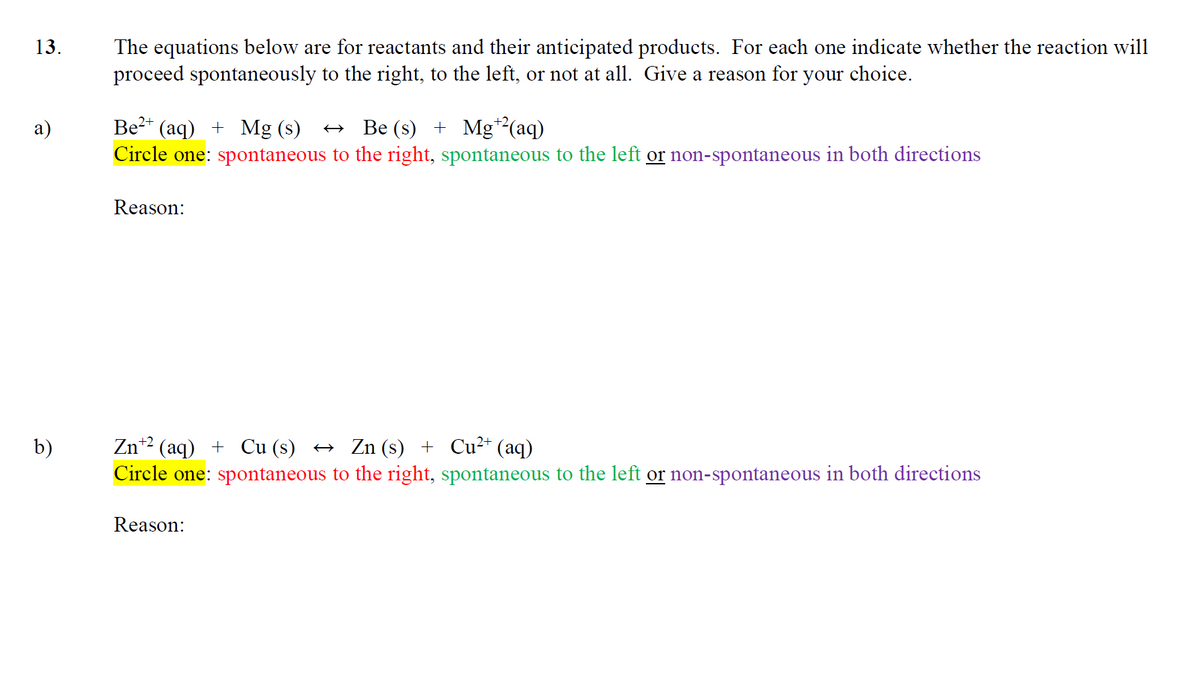The equations below are for reactants and their anticipated products. For each one indicate whether the reaction will proceed spontaneously to the right, to the left, or not at all. Give a reason for your choice. Be2+ (aq) + Mg (s) Be (s) + Mg¹2(aq) Circle one: spontaneous to the right, spontaneous to the left or non-spontaneous in both directions Reason: Zn+2 (aq) + Cu (s) → Zn (s) + Cu²+ (aq) Circle one: spontaneous to the right, spontaneous to the left or non-spontaneous in both directions Reason:
The equations below are for reactants and their anticipated products. For each one indicate whether the reaction will proceed spontaneously to the right, to the left, or not at all. Give a reason for your choice. Be2+ (aq) + Mg (s) Be (s) + Mg¹2(aq) Circle one: spontaneous to the right, spontaneous to the left or non-spontaneous in both directions Reason: Zn+2 (aq) + Cu (s) → Zn (s) + Cu²+ (aq) Circle one: spontaneous to the right, spontaneous to the left or non-spontaneous in both directions Reason:
Chemistry by OpenStax (2015-05-04)
1st Edition
ISBN:9781938168390
Author:Klaus Theopold, Richard H Langley, Paul Flowers, William R. Robinson, Mark Blaser
Publisher:Klaus Theopold, Richard H Langley, Paul Flowers, William R. Robinson, Mark Blaser
Chapter16: Thermodynamics
Section: Chapter Questions
Problem 37E: Consider the decomposition of red mercury(II) oxide under standard state conditions.....
Related questions
Question
100%
Hey, I need some help on this :)

Transcribed Image Text:13.
a)
b)
The equations below are for reactants and their anticipated products. For each one indicate whether the reaction will
proceed spontaneously to the right, to the left, or not at all. Give a reason for your choice.
Be²+ (aq) + Mg (s) → Be (s) + Mg¹²(aq)
Circle one: spontaneous to the right, spontaneous to the left or non-spontaneous in both directions
Reason:
Zn+² (aq) + Cu (s) ↔ Zn (s) + Cu²+ (aq)
Circle one: spontaneous to the right, spontaneous to the left or non-spontaneous in both directions
Reason:
Expert Solution
This question has been solved!
Explore an expertly crafted, step-by-step solution for a thorough understanding of key concepts.
Step by step
Solved in 3 steps with 2 images

Knowledge Booster
Learn more about
Need a deep-dive on the concept behind this application? Look no further. Learn more about this topic, chemistry and related others by exploring similar questions and additional content below.Recommended textbooks for you

Chemistry by OpenStax (2015-05-04)
Chemistry
ISBN:
9781938168390
Author:
Klaus Theopold, Richard H Langley, Paul Flowers, William R. Robinson, Mark Blaser
Publisher:
OpenStax

Chemistry: Principles and Practice
Chemistry
ISBN:
9780534420123
Author:
Daniel L. Reger, Scott R. Goode, David W. Ball, Edward Mercer
Publisher:
Cengage Learning


Chemistry by OpenStax (2015-05-04)
Chemistry
ISBN:
9781938168390
Author:
Klaus Theopold, Richard H Langley, Paul Flowers, William R. Robinson, Mark Blaser
Publisher:
OpenStax

Chemistry: Principles and Practice
Chemistry
ISBN:
9780534420123
Author:
Daniel L. Reger, Scott R. Goode, David W. Ball, Edward Mercer
Publisher:
Cengage Learning


Chemistry
Chemistry
ISBN:
9781305957404
Author:
Steven S. Zumdahl, Susan A. Zumdahl, Donald J. DeCoste
Publisher:
Cengage Learning

Chemistry: An Atoms First Approach
Chemistry
ISBN:
9781305079243
Author:
Steven S. Zumdahl, Susan A. Zumdahl
Publisher:
Cengage Learning

Chemistry for Engineering Students
Chemistry
ISBN:
9781337398909
Author:
Lawrence S. Brown, Tom Holme
Publisher:
Cengage Learning